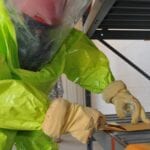 The Department of Homeland Security’s Science and Technology Directorate and the Pacific Northwest National Laboratory (PNNL) have recently released a report summarizing an extensive list of commercially available, hand-portable detection technologies for biological threats.
The Department of Homeland Security’s Science and Technology Directorate and the Pacific Northwest National Laboratory (PNNL) have recently released a report summarizing an extensive list of commercially available, hand-portable detection technologies for biological threats.
The report helps first responders such as firefighters, HazMat workers and police officers make informed decisions about procuring the right technology for their particular need and circumstance.
“The report serves as a product buying guide for end-users as well as procurement specialists,” says Cindy Bruckner-Lea, PNNL project manager. “It provides specifics and details on dozens of commercially available technologies. This free report will be an important and useful resource for first response teams everywhere.”
The release of the report is one part of a larger effort at PNNL to create partnerships with first responders that provide value to all parties. Early on in the process, PNNL conducted dozens of interviews and surveys, and held a workshop at Seattle’s Joint Training Facility to better understand first responder biodetection and information needs, gaps and priorities. The exchanges helped researchers have a better grasp of the context by which first responders perform their duties. This leads to better results and the ability to get the best solution faster and more efficiently.
According to law enforcement statistics, HazMat teams across the country respond to hundreds of white powder calls each year in large cities where quick decision-making is critical. Having the right field-deployable equipment available to determine what the suspicious substance is can be complicated, challenging and expensive.
“Rapid biodetection is extremely important to the first responder community. In white powder response incidents where the health and safety of individuals may be in jeopardy, accurate and reliable results are needed promptly,” says Seattle Fire Department, Assistant Chief, A.D. Vickery.
The information listed in the report is primarily provided by the vendor with some supplementation by PNNL with additional information obtained from peer-reviewed publications, reports and websites that evaluate the performance of the technologies. Other findings and results will be published as the information becomes available.
In coming months, PNNL will be conducting third-party testing of biodetection assay systems and instruments. Researchers will publish a report outlining performance testing in working with anthrax, ricin and commonly encountered white powders.
Read the full report at the PNNL website: Biodetection Technologies for First Responders (.pdf)
Source: PNNL


